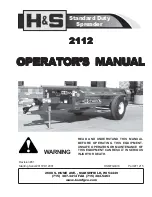
GAN UHF
Read only
Installation instructions
UHF GAN
Lecture seule
Notice d’installation
UHF GAN
Solo lectura
Manual de instalación
© STid - 20 PA des Pradeaux FR13850 Gréasque - NI1090X07 - Page
1
sur
10
-
Ed. 06/05/2019
Power supply characteristics
GAN-E power supply
Use an AC/DC LPS (Limited Power Source) type power supply (as per IEC EN 60950-1 Ed2) and PS1 (as per IEC EN 62368-1 Ed2) for the main supply.
Main power supply: Range: +9 Vdc to +36 Vdc
Typical: 12 Vdc
Consumption:
Typical: 500mA at +12 Vdc
Max.: 750mA at +12 Vdc
GAN-F power supply
Use an IEEE 802.3af.2003-compatible PSE (Power Sourcing Equipment)
Main power supply: Range +44 Vdc to +57 Vdc
Typical: +48 Vdc
Characteristics
Communication:
RS485 (L+ & L-) / RS232 (TD & RD) / TTL (Wiegand / Clock & Data) / Ethernet (RJ45)
Pin out:
Removable 12-pin connectors, thread 3.81 mm / 0.149 in
Temperature:
-20 to +55 °C / -4 to +131 °F
Protection:
IP65 level
Chip:
EPC1 Gen2 (ISO 18000-63) - 96 bits max.
Relay:
1 A max. at 30 Vdc operated by reading or by LED2
IN input:
Anti-bounce circuit for crossed connection detection
LEDs:
Two of the seven available colors (default: LED1: red; LED2: green)
Tearing:
Cover open detection switch (configured with the configuration tag)
Recommended cables
Use a multi-conductor shielded twisted pair cable.
Max. length RS485: 3,280.84 ft / 1,000 m at 9,600 baud (
SYT2 AWG24 recommended
).
Max. length RS232: 49.21 ft / 15 m (
SYT2 AWG24 recommended
).
Wiegand / Clock & Data:
1 pair AWG24
– 30 m / 98.43 ft max.
2 pairs AWG24
– 60 m / 196.85 ft max.
3 pairs AWG24
– 100 m / 328.08 ft max.
1 pair AWG20
– 50 m / 164.04 ft max. 2 pairs AWG20 – 100 m / 328.08 ft max.
Recommendations
▪
Install the module/reader well clear of computer communications cables or power sources (ex: RJ45, mains, etc.).
The disruptions that they can cause vary according to their radiation power and proximity.
▪
Use a filtered and regulated power supply.
▪
Antennas connected to the different modules/readers may interfere with each other. Move them all clear of one other.
▪
A power supply supplying 1.5 A min. at +12 Vdc is recommended.
▪
Users must not remain within 25 cm / 9.8 in
of an antenna for an extended period of time, as per EN50364 applicable to this type of device.
▪
Always de-energize the reader before servicing
.
▪
Do not look at the display LED with the cover open.
▪
Do not overtighten the cover attaching screws, as this will crush the waterproof seal.
Start sequence
▪
When the reader is switched on, the white LED stays alight during the initialization of the reader (2 seconds) and the buzzer emits a series of beeps: 2 long + 1
short + 2 long.
After initializing, the reader looks for a configuration tag on the antenna, and the orange LED flashes for 4 seconds.
If a configuration tag is detected, the LED indicates:
- The green LED flashes quickly six times and the buzzer sounds at the same time: the tag is recognized.
- The red LED flashes quickly six times: the tag does not match the reader model.
- The purple LED flashes quickly six times: the tag key is different from the reader key.
- The red LED flashes twice (2x1 seconds, the buzzer sounds at the same time): the power setting in the tag does not match the reader
regulation. In
dication available for firmware version ≥ SZ221A02, the firmware version is indicated on the reader label.
▪
The reader can manage anti-collision of up to four tags.
If there are several tags in front of the reader, the codes are sent one by one with a delay of 200 ms in TTL and without any delay over serial links.
The scan cycle varies according to the number of tags present in front of the antenna. The fastest are:
- 30 ms for FCC, Australian and New Zealand regulations.
- 100 ms for ETSI and Moroccan regulations.
▪
By default, when the reader reads a tag, green display LED, buzzer and relay are activated once for 200 ms
.
Optional Boost mode (ETSI version only)
▪
To improve performance, it is possible to increase the power of the reader, while respecting the current regulations.
The Boost mode is ONLY AVAILABLE for the ETSI version
.
▪
Procedure:
-
Reader powered off. Put the jumper C-J18 in position 1-2.
-
Keep the anti-tear switch closed (by closing the hood or by holding it by hand).
-
Power on the reader.
Note: to use this Boost mode, the power initially configured by configuration card must be 100%. Note: to return to the non-boost mode, power off
the reader, put the jumper C-J18 on 2-3 and restart the reader.
Product references
GAN-R
x
1-E-U04: TTL
GAN-R
x
2-E-U04: RS232
GAN-R
x
3-E-U04: RS485
GAN-Rx4-E-U04: ETHERNET
GAN-Rx4-F-U04: ET PoE
Regulation x:
4 ETSI (European standard)
5 FCC (American standard)
6 Moroccan regulation
7 Australian standard
8 New Zealand standard
US
FR
ES




























